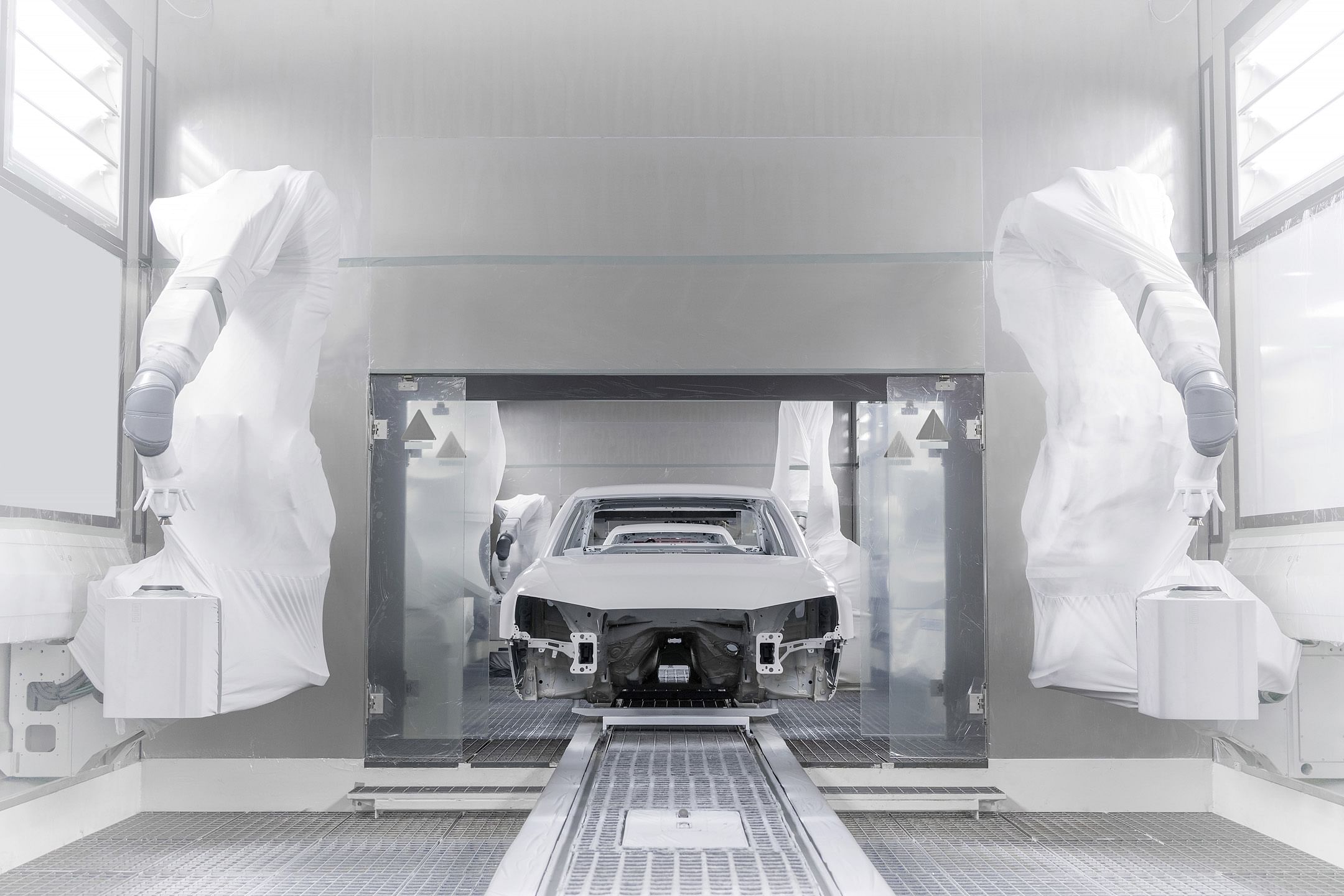Audi opens new, highly efficient paint shop in Ingolstadt plant
Efficient technologies make this one of the world’s most eco-friendly paint shops. It can paint up to 900 car bodies a day on three floors.
Audi has put a new topcoat paint shop into operation at its plant in Ingolstadt. Board of Management Member for Production Prof. Dr. Hubert Waltl opened the 12,000 square metre building today together with plant director Albert Mayer and Group Works Council Chairman Peter Mosch.
Up to 900 car bodies a day can be painted there on three floors. Thanks to environmentally friendly technology, the modern application equipment will conserve resources. Ergonomically designed workplaces will make the employees’ work easier.
Approximately 200 employees work in the new paint shop in three‑shift operation, supported by 54 painting robots, 36 handling robots and eight cleaning robots. Start of construction of the new hall, which is 324 metres long, 36 metres wide and 32 metres high, was in April 2014. Installation of equipment started in March 2015 and the topping‑out ceremony was in July.
Series operation began in spring 2016 after a construction period of just two years. At present, 650 car bodies are painted there each day; the maximum daily capacity of approximately 900 cars per day is to be achieved by the end of the year. The Audi A4 and A5 models are currently painted in the new paint shop, later to be followed by the A3 and Q2.
The new paint shop is one of the most environmentally friendly in the world, resulting from state‑of‑the‑art technologies such as air recirculation, dry separation and exhaust air cleaning. These measures allow a significant reduction in the use of resources, so that heating energy and water consumption per car are reduced by 20 percent. Air recirculation also helps to reduce CO₂‑emissions per painted car by 30 percent, while the cleaning of exhaust air reduces emissions of volatile organic compounds (VOCs) by 90 percent.
Prof. Dr. Hubert Waltl, Member of the Board of Management of Audi AG for Production and Logistics, stated: “Sustainable operations have high priority at Audi. That’s why we are continually further developing our production technologies. This is the only way for us to live up to our high demands in terms of quality, environmental compatibility and energy efficiency. With the construction of the new paint shop, we placed great importance on high standards of resource efficiency and ecology.”
State-of-the-art painting technology
The new topcoat point line‑in the north of the plant site also introduces state‑of‑the‑art painting technology at Audi: Paint‑application equipment with robot technology and electrostatic high‑speed rotation spray guns carry out the painting process fully automatically. With the so‑called bell‑bell method, paint is applied only electrostatically, thus achieving higher efficiency (depicted below). In combination with dry separation, this also benefits the environment. Five‑percent less waste (paint sludge) is created for each car that is painted.

The complete topcoat painting process for an Audi model lasts about three hours. The car bodies pass through three stations for the application of filler, basecoat and clear paint. After each step of the process, the painted car bodies pass through a drier. The carmaker places great emphasis on efficiency also with this equipment: The energy required for a constant temperature in the drier cabins is optimally adjusted to the number of car bodies to be dried. Hot air passes through special air vents pointing towards the car bodies.
The new topcoat line is also a further component of the fully connected intelligent factory of the future, the smart factory. For example, a big‑data robot measures the painted automobiles at more than 100 measuring points. Employees use the data on quality collected in this way to compare with existing process data. This comparison helps to prevent possible production flaws in the electronic quality process, with support from an electronic quality inspection. For this purpose, touchscreen clients are used that work like tablets and provide the employees with the collated data in direct and indirect areas. This means that all of the departments involved in the production process are connected and can work with the latest data.
Audi says it places great importance on the ergonomic design of workplaces. For example, height‑adjustable platforms in the new paint shop allow an optimal working environment. Handling devices such as lifting aids for the car hood and tailgate assist the employees in the working process. Another new feature is the worker conveyor belt, which carries the employees when they are working directly on the car bodies. Instead of using stationary tool stations, items such as polishing machines and paste are always within reach in the trolley carried next to them.
Also read: Audi sells 132,350 units worldwide in August, up 2.9% YoY
RELATED ARTICLES
Volvo Cars signs recycled steel supply pact with SSAB
The recycled steel will be used in selected components of the forthcoming, fully electric EX60 SUV, as well as other car...
Schaeffler and NVIDIA ink technology collaboration to advance digital manufacturing
Using NVIDIA Omniverse, Schaeffler is expanding its production elements, which will be integrated and simulated as digit...
BMW Group to industrialise Virtual Factory, slash production planning costs
What once required several weeks of real-world modifications and testing can now be precisely simulated in the BMW Group...





 By Autocar Professional Bureau
By Autocar Professional Bureau
 20 Sep 2016
20 Sep 2016
 6368 Views
6368 Views
















